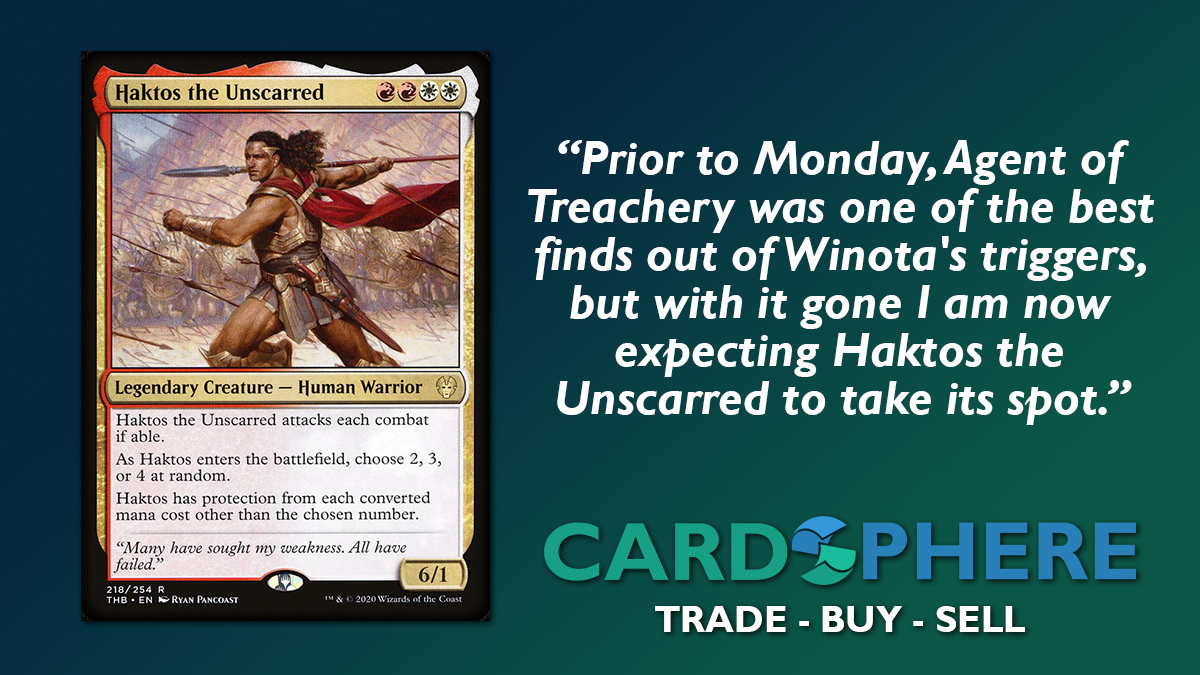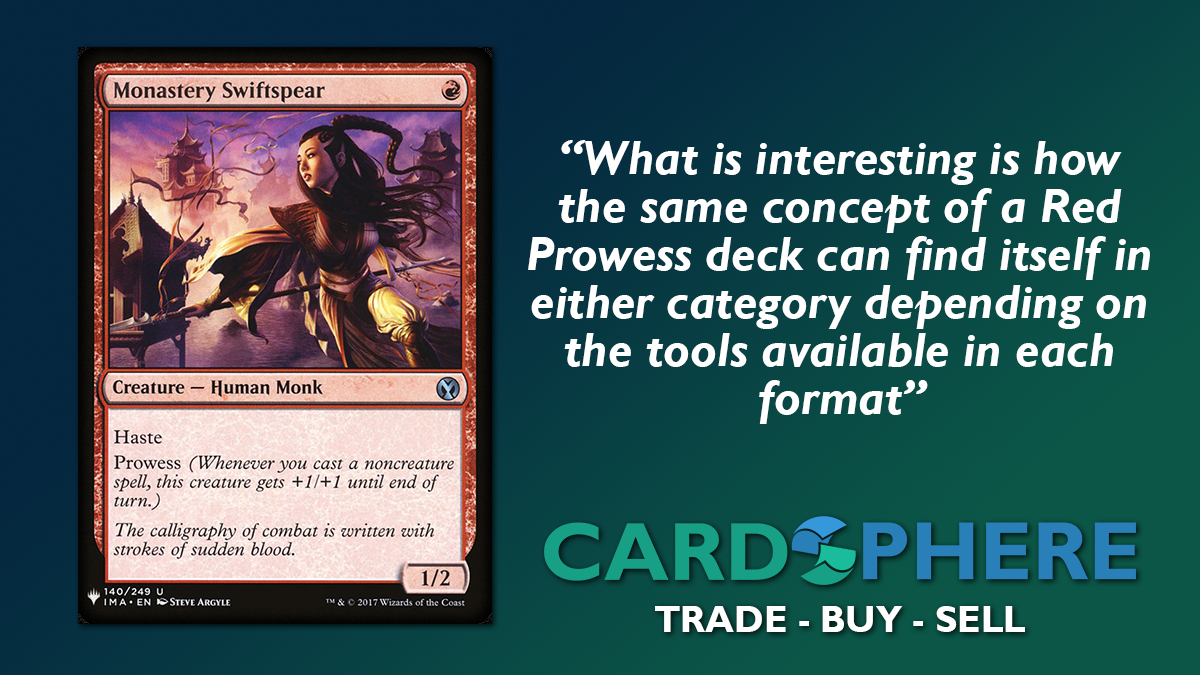Swing and a Miss: Consequences of the June 1st B&R Update

Booooo!
Let's be honest, we were all expecting something different today. Anticipation had started building the week before, when WotC once again announced their announcement: changes were coming to Standard, Historic and the companion mechanic. Critics had been voicing their discontent about Standard for a while, pretty much since after the first weekend of Ikoria becoming legal on Arena because of some of the Companions (Lurrus of the Dream-Den and Yorion, Sky Nomad being the main culprits) and Lukka, Coppercoat Outcast, but it is the emergence of the Naya Winota archetype that provoked the latest cry for bannings. Khans of Tarkir is the last set I can remember that provoked such a ruckus among the players base due to the Delve mechanic, which ended up being completely justified when you remember how much Treasure Cruise and Dig Through Time impacted Modern at the time.
Leading to this (Monday) morning, many had made their predictions. I was personally hoping that two cards would be getting strong consideration for a ban: Teferi, Time Raveler in Standard, and Winota, Joiner of Forces in Historic - although I would have been ok with an errata on Winota, like having her attack too as part of her triggered ability. Veil of Summer got banned, and I quote, for "preventing the metagame from being able to self-correct" but the same could be said about Teferi. Earlier in the Standard season, people were already pointing out how miserable it was to have to answer a Turn 3 Teferi at sorcery speed, but the advent of the Lukka/Yorion builds completely warped the metagame. Something had to happen.
Maybe that was too much to ask for, though. Agent of Treachery and Fires of Invention were deemed to be a bigger problem instead, both in Standard and Historic. Technically speaking, they are only suspended in Historic - leaving the door open for a return at a later date, a la Field of the Dead, which is a nice advantage this format has for being Arena exclusive. The companion mechanic, on the other hand, is on the receiving end of a much more drastic change: players now have to pay a 3 mana tax before they get to play their favorite pet from their hand.

Every companion instantly felt way less attractive, even Lutri, the Spellchaser, poor thing; but that didn't last long once I considered what all those changes meant for the Standard, Modern and Pioneer metagames leading into this weekend. Ready to dive in?

Standard
1. The Lukka/Yorion Problem
To a large extent, banning Agent of Treachery and Fires of Invention is an attempt at lowering the metagame shares of the Lukka/Yorion build - and it will be succesful at first. For one thing, there can no longer be any gross Turn 5 sequences like: play Lukka, get Agent and steal a permanent (likely a land), play Yorion which usually bounces a couple of Omens, Lukka and Agent - then get everything back and steal yet another permanent. Yikes.
But is it going to make that much of a difference? In the case of Yorion builds in general, which are traditionally more of the Control/Midrange type, the companion Rule change makes little difference since those builds aim for the longer game. So having to pay 3 at sorcery speed is not that much of a thorn in their side, especially when you get a larger maindeck size to add intermediate ressources - which one will still get to benefit from when they eventually play Yorion, Sky Nomad.
Next, finding a replacement to Fires of Invention is functionally impossible, but it could mean a free slot at 4 CMC to put some copies of Narset of the Ancient Way, or a few different controlling pieces like Absorb, Disdainful Stroke or even Shatter the Sky if Aggro builds are to make a stong push in this new environment.
And then there is the issue with Agent of Treachery: the main reason why Lukka, Coppercoat Outcast is even in the deck to begin with (and by extension the reason why the deck is Jeskai/Raugrin rather than straight Azorius) is to use the tokens produced to go fetch Agent out of the deck. Without Agent, the build either has to find a replacement of equal impact on the board, or move away from Lukka altogether. I can think of two potential replacements right away:
- Yorion, Sky Nomad: after all, why not run some copies of the companion in the maindeck? It is a very good value engine considering the rest of the build, and with its companion clause enforcing for a larger decklist we know there are some slots available, even more so now with both Fires and Agent gone;
- Yidaro, Wandering Monster: now that is my kind of spice! Just like Agent of Treachery was, Yidaro is not intended to be played "fairly" from the hand: between its own ability and Lukka's there are two ways to cheat into play an 8/8 Haste, trample monstrosity. Granted this does not shift the board advantage as dramatically as Agent can, but I believe it deserves at least some consideration since Yidaro is never a dead card in hand if you draw it in the first few turns of the game.

Another card worth mentioning here is Kenrith, the Returned King which could act as another above-average replacement to Agent of Treachery. I find it a little mana intensive for the current version of Lukka/Yorion decks, however I am definitely keeping an eye on it.
I am fully expecting Lukka/Yorion to still be a thing come Thursday; but it should now allow for more balanced gameplay - at least on paper.
2. Winners and Losers from the rest of the field
The companion Rule change has some clear, drastic consequences for a number of other builds in Standard:
- Yorion Bant Ramp;
- Lurrus Rakdos Sacrifice;
- Lurrus MonoW/Selesnya Auras;
- Gyruda Combo;
- Umori Mutate;
- Lurrus Jeskai cycling;
- Lurrus Mardu Knights;
- Obosh red.
The new 3 mana Companion clause has two main effects: loss of consistency/efficiency, and loss of tempo. As far as Yorion Bant Ramp is concerned, the same arguments that I presented above for including Yorion, Sky Nomad in the maindeck of Lukka deck also apply to the Ramp strategy. The main issue for the other archetypes is therefore assessing how critical their companion is to the overall strategy of the build:
- consistency/efficiency: one has to look at whether their companion was a huge part of their plan, or just a nice added bonus; in that context, one could argue that Jeskai cycling, MonoW/Selesnya Auras and Mardu Knights can remain fully functional even without having access to their companion, while Rakdos Sacrifice could simply include Lurrus of the Dream-Den in the maindeck and stay the course;
- tempo: the loss of tempo might be too much to recover for Gyruda Combo, Umori Mutate and Obosh red, which would pretty much have to give up a whole turn just to get their companion in hand; still, it was not long ago that Monored player were using Torbran, Thane of Red Fell so it is very likely that at least some version of Monored will try running 2-3 copies of Obosh, the Preypiercer - however Torbran/Embercleave builds have the advantage of a solid track record.

Meanwhile, we cannot forget the archetypes that do not include Companions:
- Temur Clover;
- Temur Reclamation;
- Jund Sacrifice;
- Winota Midrange.
Clover and Reclamation builds have both received some upgrades from Ikoria in Adventurous Impulse and Shark Typhoon respectively, which both add consistency and inevitability to each deck. Jund Sacrifice is still riding the true and tested power of Mayhem Devil, but some version are now running Bolas's Citadel (for grindy matchups) as well as Korvold, Fae-Cursed King (against Aggro as a strong board presence) to quite some success: in the MtGO Standard Challenge this past weekend, the top 8 was made of 4 Lukka/Yorion, 1 Selesnya Auras and 3 copies of Jund Sacrifice. Quite the resurgence!
The new kid on the block is Winota Midrange, which placed 2nd at the recent E-League Arena event piloted by Emma Handy. The idea is to use efficient early creatures (Charming Prince, Alirios, EnraptuRed, Legion Warboss) that can then turn into as many attack triggers for Winota, Joiner of Forces, which can be poweRed into play early via Neoform. Prior to Monday, Agent of Treachery was one of the best finds out of Winota's triggers, but with it gone I am now expecting Haktos the UnscarRed to take its spot. Being one of the most recent additions to the metagame, it will be interesting to see how it fares in the new shape of the metagame.
3. (Very) Early Power Rankings
Based on the data available thanks to the wonderful people at MtGmeta.io, and using the considerations above, here are my very early and equally humble Standard Power Rankings between the different builds discussed above:
Tier 1:
Temur Reclamation
Yorion Bant Ramp
Jeskai cycling
Jund Sacrifice
Tier 2:
Temur Clover
Yorion Azorius Control
Yorion Jeskai Lukka
Monored Cleave
Tier 3:
Rakdos Sacrifice
MonoW/Selesnya Auras
Winota Midrange
Modern and Pioneer
Let's first have a look at some of the most recent MtGO results of competitive events:


Eternal formats are pretty much only affected by the change to the companion Rule, as neither Agent of Treachery nor Fires of Invention was seeing enough significant play prior to Monday. And just like in Standard, one can find the same split between decks that run companion cards: those that use it as a core part of the build, and those that do not depend on the card all that much but benefit greatly from it once it gets played.

What is interesting is how the same concept of a red prowess deck can find itself in either category depending on the tools available in each format. Below are the latest iterations of RB prowess (with or without Tarmogoyf) in Modern, and Boros Aggro/Burn in Pioneer.
4 Monastery Swiftspear
4 Soul-Scar Mage
4 Tarmogoyf
4 Thoughtseize
3 Cling to Dust
4 Fatal Push
2 Kolaghan's Command
4 Lightning Bolt
4 Manamorphose
4 Mishra's Bauble
1 Nihil Spellbomb
3 Seal of Fire
4 Blackcleave Cliffs
1 Blood Crypt
4 Bloodstained Mire
2 Mountain
1 Nurturing Peatland
1 Overgrown Tomb
1 Stomping Ground
1 Swamp
4 Wooded Foothills
2 Nihil Spellbomb
2 Angrath's Rampage
3 Collective Brutality
2 Kiln Fiend
1 Lurrus of the Dream Den
3 Molten Rain
2 Unearth2 Ash Zealot
4 Eidolon of the Great Revel
4 Ghitu Lavarunner
4 Monastery Swiftspear
4 Soul-Scar Mage
4 Viashino Pyromancer
4 Light Up the Stage
4 Boros Charm
2 Lightning Strike
1 Shock
4 Wild Slash
4 Wizard's Lightning
4 Battlefield Forge
4 Inspiring Vantage
7 Mountain
4 SacRed Foundry
4 Chained to the Rocks
2 Light of Hope
1 Lurrus of the Dream Den
4 Searing Blood
4 SkullcrackThe very significant difference between them is how RB prowess definitely relies on the interactions between Lurrus of the Dream-Den and the duo of Mishra's Bauble and Seal of Fire to bring the deck to its full potential by abusing Lurrus's ability to bring those permanents back. It is even more egregious when you take into consideration the amount of card advantage one gets from (a) being able to reliably land Lurrus when needed and (b) drawing cards repeatedly with Bauble turn after turn in a Burn/Aggro shell that is traditionally starving for card draw. On the other hand, the Pioneer build relies more heavily on its array of burn spells, and brings in Lurrus for its lifelink ability and being able to bring back more threats in the event the board was wiped.
Looking again at the Top16 lists I posted above, it appears that another build that relies on its Companion is the Gyruda Combo archetype in Pioneer, which uses all even CMC clones available in the format ( AlteRed Ego, Clever Impersonator, Spark Double, Vizier of Many Faces) to build an insurmountable board presence, or even attack right away if Dragonlord Kolaghan was found as part of the cycle. Similarly to its Standard counterpart, the new rule change might have simply spelled the doom of this archetype.
Last but not least, there is the case of Yorion Jeskai Lukka in Pioneer, which takes on more of a Jeskai Superfriends build:
2 Agent of Treachery
3 Gideon of the Trials
2 Gideon, Ally of Zendikar
4 Lukka, Coppercoat Outcast
4 Narset, Parter of Veils
4 Teferi, Time Raveler
1 Island
1 Mountain
3 Plains
1 Castle Ardenvale
1 Castle Vantress
2 Clifftop Retreat
2 Fabled Passage
2 Glacial Fortress
4 Hallowed Fountain
3 Irrigated Farmland
4 Raugrin Triome
3 SacRed Foundry
3 Steam Vents
3 Sulfur Falls
1 Temple of Enlightenment
1 Temple of Epiphany
2 Baffling End
2 Elspeth Conquers Death
4 Fires of Invention
4 Omen of the Sea
3 Shark Typhoon
4 The Birth of Meletis
3 Oath of Chandra
2 Deafening Clarion
2 Supreme Verdict
2 Resolute Archangel
2 Void Winnower
3 Rest in Peace
3 Mystical Dispute
1 Yorion, Sky Nomad
1 Gideon of the Trials
3 Teyo, the ShieldmageHere, the ability to play Yorion straight out of the sideboard is significant because it allows resetting all of one's Planeswalkers, Baffling End, Omen of the Sea and/or Elspeth Conquers Death. The deck has started posting Top4 results rather consistently for the past couple of weeks, and Fires of Invention/Agent of Treachery are still legal in the format for now, so let's see how long this ride will last.
Other than those three specific examples, the other relevant builds only aim at gaining some advantage from running a companion just as an eighth card in hand:
- Bant UroZa and 4-color Control (Modern) can use Yorion to bounce Arcum's Astrolabe, Ice-Fang Coatl and Wall of Blossoms for card draw, Oath of Kaya for extra removal and Urza, Lord High Artificer for more board presence;
- Bogles (Modern) can use Lurrus to recover any destroyed Aura or a sacrificed Totem Armor;
- Hardened Scales (Modern) can use Lurrus in a similar way to replay some of the Artifacts sacrificed to Arcbound Ravager;
- Ensoul Artifact (Pioneer) uses Lurrus in an identical way to Hardened Scales;
- Azorius/Esper/Grixis Control (Modern, Pioneer) will play Yorion to reset their Planeswalkers and abuse various Enchantment ETB triggers (Omen of the Sea, Trial of Ambition, Elspeth Conquers Death...), much like described previously for the Yorion Jeskai Lukka archetype.
As is the case in Standard, Control and Midrange type decks in Modern as well as Pioneer will still be able to use Yorion, Sky Nomad as their companion because its clause is not a real restriction for those builds, and they can also afford the newly implemented tax without losing too much tempo in their overall gameplan.
The Times, They Are A-Changin'
The next few weeks are going to be a bit weird: on one hand, players get to explore brand new metagames in Standard, Modern and Pioneer due to the latest B&R update, which clearly will have an impact. On the other hand, this Thursday is also the start of Preview Season for the Core 21 set, announced to be Teferi-centric and bring back an old, non-everGreen mechanic. So there will be an inclination to think that the new metagames will be short-lived, therefore people might default to the known quantities - especially in Standard with Temur Reclamation and Bant Ramp.
I choose to look at it positively, mostly because I love the brewing and puzzle-solving aspect of Magic: I am very much looking forward to what the new set is going to bring and start looking for new archetypes and updates to existing ones. Am I overly positive for things to be great in the face of yet another series of bannings to multiple formats? Absolutely - because great things can only come from changes. And boy are changes needed these days...
